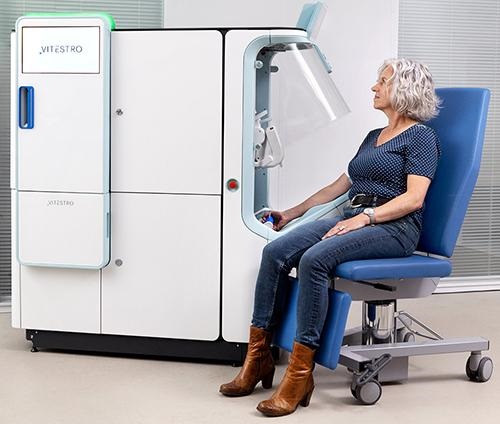Should this AI-driven technology prove viable in clinical settings, it could contribute to easing the shortage of qualitied phlebotomists for medical laboratories worldwide
Could phlebotomists one day be out of a job? If European medical technology company Vitestro has its way, that could someday become a reality in European hospitals and in clinical laboratories worldwide. Headquartered in the Netherlands, the company has raised EUR 12.7 million ($14,057,947.50 US) in Series A financing to bring to market “the world’s first autonomous blood drawing device,” BioWorld Med Tech reported.
According to Vitestro’s website, the “device combines AI-based, ultrasound-guided 3D reconstruction with robotic needle insertion, ensuring accurate and secure blood collection. The procedure is performed fully automatically, from tourniquet to bandage application.”
This is another example of how artificial intelligence companies are finding opportunities in staffing shortages the healthcare industry is experiencing globally. In this case, the novel technology could help address the lack of qualified phlebotomists. And clinical laboratories around the world could become the proving grounds for new AI-driven devices that end up replacing human healthcare workers.

“This financing round marks a new phase of growth for Vitestro which brings the company closer to its mission of improving the venipuncture procedure for hundreds of millions of patients per year,” said Vitestro CEO and co-founder Toon Overbeeke (above), in a press release. “We look forward to growing the business and transforming patient care with Sonder Capital, leveraging their expertise in successfully commercializing medical robotic technologies.” If proven viable, clinical laboratories around the world suffering from shortages of phlebotomists could benefit from AI-driven autonomous blood draw stations. (Photo copyright: LinkedIn.)
Next Evolution for Clinical Laboratories
According to the Centers for Disease Control and Prevention (CDC), there are 14 billion clinical laboratory tests ordered annually in the US and 70% of medical decisions depend on laboratory results. One of the more common clinical laboratory procedures—venous blood draws—is pivotal in clinical diagnostics, but a worldwide shortage of skilled phlebotomists is having an impact on this critical testing method.
With the announcement of its completion of a EUR 12.7-million Series A financing round to bring the “world’s first” autonomous blood draw device to market, Vitestro seems poised to impact both the shortage and the job prospects of existing phlebotomists. This financing round was led by San Carlos, California-based Sonder Capital and included investors with experience in the clinical laboratory and medical technology industries.
“Automating this ubiquitous procedure is the next evolution for clinical laboratories, allowing them to improve quality of care for patients while building a more sustainable operation,” stated Andy McGibbon, Managing Partner at Sonder Capital in a March press release.
According to Investopedia, Series A financing refers to “an investment in a privately-held start-up company after it has shown progress in building its business model and demonstrates the potential to grow and generate revenue. It often refers to the first round of venture money a firm raises after seed and angel investors.”
Vitestro says it will utilize the capital from this financing round to accelerate production development, prepare market authorization in the European Union, and initiate production.

Vitestro’s autonomous blood drawing device prototype (above) has been tested on more than 1,000 volunteers and patients. Vitestro plans to continue its studies on the device this year and anticipates entering the European market with the device sometime in 2024. Development of this technology is something that phlebotomists and clinical laboratory managers will want to track. (Photo copyright: Vitestro.)
Coming to a Clinical Laboratory Near You
“Medical robotics will make optimal outcomes available to everyone. I strongly believe Vitestro will set the world standard in autonomous blood drawing,” said Fred Moll, MD, Managing Partner of Sonder Capital in the press release. Moll, who has been heralded as the “father of robotic surgery,” was also appointed as a non-executive board member of Vitestro. Moll co-founded Intuitive Surgical, Inc., Hansen Medical, Restoration Robotics, and Auris Health (acquired by Ethicon, a Johnson and Johnson company).
On April 12, Vitestro announced that leading Dutch clinical laboratory OLVG Lab will be the first healthcare provider to begin using their blood-drawing device. A number of hospitals, clinical laboratories, and blood drawing departments are preparing to use the device and OLVG Lab plans to have the system fully operational by late next year, according to a press release. OLVG lab provides laboratory services to hospitals, clinics, and care providers in the greater Amsterdam area.
“Robotization has become an important topic in diagnostics. Vitestro’s technology will improve the standardization and optimization of the sampling procedure. And it helps solve staff shortages in our blood drawing department,” said Anja Leyte, director of OLVG Lab, in the press release. “But more importantly, the patients are also very positive. Our staff are really enthusiastic as well and can’t wait to start using this breakthrough technology in our healthcare.”
Vitestro’s device is still in the testing phase but could prove to be very beneficial to clinical laboratories and help alleviate the shortage of trained phlebotomists. An automated blood draw machine might also improve the consistency of the blood draw experience for both patients and healthcare professionals.
—JP Schlingman
Related Information:
Amsterdam-based OLVG Lab Adopts Vitestro’s Autonomous Blood Drawing Devices



